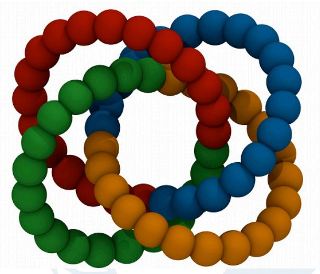Mar 11 2015
As sailors and mountaineers know very well, every knot carries out a specific function. There's a knot that slides, one that "floats", and one that comes undone with a single pull. In the field of nanotechnology as well, it is useful to have several kinds of molecular knots to be used, for instance, as mechanically resistant nano-cages for delivering chemical compounds or for confining and controlling toxic reagents.

So far, molecular knots have only been produced by chemical synthesis, obtaining constructs on an atomic scale. In the study coordinated by SISSA professor Cristian Micheletti, a team of researchers (from the Universities of Edinburgh and Padova as well as from SISSA) have tackled a previously unmet challenge: obtaining larger-scale knots starting from molecular building blocks with a specific shape and "sticky" ends allowing the fragments to assemble themselves spontaneously. Left free to move and interact in a solution, these fragments stick to one another to form complex three-dimensional units. How can we exploit this process to obtain a knot that has a specific shape? "It is necessary to study precisely the shape of the fragment", explains Cristian Micheletti, SISSA scientist and study coordinator. "So first we did that by using computer simulations and then we drew up a 'catalogue' of fragments for each use". The results have just been published in Nature Communications.
The study simulated the self-assembly of differently shaped fragments interacting in a virtual solution, successively modifying specific parameters in the shape of the fragments. "This way we selected the most suitable shapes for assembling various types of knots" explains Micheletti.
Molecular knots may find application in the field of nanotechnology, to construct nanodevices serving different functions. "Our study", concludes Guido Polles, SISSA student and first author of the paper, "should serve as a guide for experimentalists who can now choose which molecular knots to produce taking into account the ease or difficulty with which each knot will spontaneously self-assemble".
"So far, all endeavours to 'design' molecular knots", continues Micheletti, "have followed the natural progression of the mathematical complexity of the knots. We discovered that this natural scale of complexity does not necessarily correlate with ease of assembly". This means that knots that are mathematically very complex may be relatively easy to assemble. "More specifically, we identified a type of knot with a particularly complex three-dimensional shape," concludes Micheletti, "which surprisingly can be assembled very efficiently starting from only four helical fragments. This makes it the most promising and interesting candidate for experimental realisation in the laboratory".
Watch video with real "building blocks" demonstration on youtube: https://youtu.be/XKsuMlp2PLc